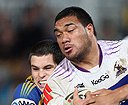 When Muhammad Ali surprised George Foreman with a powerful right in the opening seconds of their famous Rumble in the Jungle, Norman Mailer described the sound as “the unmistakable thwomp of a high-powered punch. The sound of a bat thunking into a watermelon.”
When Muhammad Ali surprised George Foreman with a powerful right in the opening seconds of their famous Rumble in the Jungle, Norman Mailer described the sound as “the unmistakable thwomp of a high-powered punch. The sound of a bat thunking into a watermelon.”
That was the type of noise I heard on the day I wandered over to Olympic Park for Melbourne Storm’s first ever home game in 1998; an intrigued observer only, but aware of the disloyalty being shown to my childhood football code.
The slap and thud of wingers colliding on the near edge was what first drew my attention.
But then from the middle came another sound – deeper and more complex, brought to me by the south-westerlies that are allowed free entry into that open-ended stadium: the noise of two props colliding at speed.
It was the sound of a carcass being reduced to bonemeal.
For me it was a turning point. The game I had previously seen only occasionally on television and dismissed as too ground-based, congested and low-scoring had become something more exhilarating.
It was like boxing because there was nowhere to hide. Players couldn’t pass the ball fifty metres backwards when they didn’t like what they saw in front of them.
There was the option to offload but more often than not they took a brutal hit to retain possession.
They become a legitimate target for impact.
Boxing, of course, is at a higher, awful level. It is fighting, with gloves – the same thing thugs who hate each other do on the streets but with knuckledusters.
The head, deemed sacrosanct in all other mainstream contact sports, is the prized target.
Ali’s scorching hit on Foreman brought cries of expectation and then a hush from the crowd, as people struggled with contradictory impulses: exhilaration at the spectacle of condoned violence, reverence for the talent of Ali, and concern for Foreman.
For some, there was also the guilt of being there – complicit in the brutality.
Fuifui Moimoi’s massive frontal assault on Brett White in the 2009 grand final drew varied responses.
From caller Ray Warren, it was disbelief: “I can’t believe he got up!” Phil Gould, a renowned lover of big hits, yelled out with glee: “Ah yes! Yes, yes… yes yes yes Mr Moimoi! Get that into you!”
All while White’s partner watched in horror as her beloved’s head rocked back and his eyeballs disappeared from view. I couldn’t believe he got up either, or held onto the ball as it bobbed in the hands while his brain realigned itself.
That was the compelling but troubling highlight for me. The ability to continue the task while the brain was traumatised.
Earlier in the same game, Dallas Johnson (not for the first time) was concussed, when he fell into a another tackle by the rampaging Moimoi, copping the swinging Popyeye-ish forearm on the jaw.
Johnson didn’t move immediately after Moimoi, and second tackler Todd Lowrie had extricated themselves.
Then, with unnatural instinct, (the natural one was to stay down) he slowly got to his feet and methodically and correctly played the ball.
Only when this was done, did the effects of a temporarily damaged brain take hold and Johnson stumbled sideways.
Sometime later, Peter Sterling commented: “The trainers are signalling to the sideline that Johnson’s no good.” They
wanted him to come off. He didn’t.
These big men are built like the massive metal cars of the 1950s that were near indestructible on the outside in a
collision, but destroyed anything inside.
Post-mortem studies in the United States of the brains of ex-NFL players are now revealing the extent of the damage that goes on inside.
The crowd naturally feels protective of the children playing the game at half-time. They shouldn’t. Their young bodies are built for impact.
Like the cars of their era, they are flexible, absorbing and then repelling the shock.
Our sympathies should lie with the halves, the little men who draw traffic from props looking for an easy way through.
Boxing weight divisions, in increments of two to three kilograms, are enforced to avoid giving fighters free rein to annihilate lighter ones.
So you can appreciate the toll that is taken when a league halfback is hit by a mass 20kgs heavier than his own.
Followers of other sports probably dismiss league as mindless and brutal. But even with the truly brutal sports like bullfighting and boxing, there is intelligence and artistry too.
There are magicians like Marshall, Thurston, Inglis, Slater and Hayne whose artistry is illuminated by the suffering going on around them.
I still follow Aussie Rules, the game I played and grew up with, but when given the choice of watching that or the “stupid brutal business” of rugby league, I choose the latter.





























































































